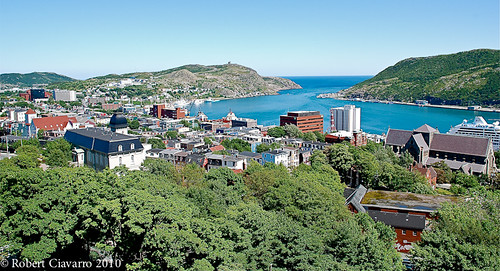What makes an ideal city for Urban Gondola implementation?
We most probably think about topographical challenges first and foremost. For example, St. John’s, Newfoundland (pictured above) would be an ideal candidate due to it’s topography, unique harbour and its iconic Signal Hill. Similarly, cities like Hamilton, Ontario or Pittsburgh or Cincinnati could also be ideal.
Really any city with any combination of hills, mountains valleys, ravines, parks, rivers, inlets, bays and harbours could be a viable Urban Gondola candidate.
But the more you think about it, the more you realize virtually every city possesses some combination of hills, mountains valleys, ravines, parks, rivers, inlets, bays and harbours. It’s in our nature to settle in these very places. There are very few reasons for humanity to settle in a purely flat blank slate environment.
The challenge, therefore, is to separate the wheat from the chaff and spot intuitively what would work where and why. And that can only come from first hand knowledge – from your experience.
So let’s ask this question: What cities can you imagine an Urban Gondola system working in? What cities have you lived in or visited that you know could benefit from an Urban Gondola or Cable Propelled Transit system? And more importantly: Why?


9 Comments
Istanbul. Why?
1. The city is cut apart by several rivers – in fact some part of the city are literally on another continent.
2. The city is covered in hills.
3. The city easily has enough density and transit use to make such a system sucessful.
4. They have a huge tourist industry, and this would provide a beautiful way of getting around.
5. The highways crossing rivers are massively clogged. I spent over a half an hour travelling a 1000ft span.
6. Talk about an expensive place to dig new subway lines – only a few decades ago they found a massive cistern under the city from Roman times (you know, back when it was Constantinople – or maybe it was back when it was Byzantium?). This is a city with serious history, and very important artifacts underground.
7. They have almost every other form of transportation already. Funiculars. Metro. Heavy rail. Light rail (“half-metro”). Streetcars. Buses. BRT. Ferries. “Sea buses”. What’s one more system?
WAIT! It turns out this exists. From Wikipedia:
“There is a short gondola lift line above the Democracy Park in the valley between Taksim and Maçka built in 1993. It connects the hotels Istanbul Hilton on one side with Parksa Hilton and Swissotel The Bosphorus on the other side. The cable line is 333 m long and transports in two cabins with six seats each around 1,000 passengers daily. The trip takes three minutes.
A second cable car line was opened in 2005 between the historical district of Eyüp and the Pierre Loti cafe on the top of the hill. It was most expensive cable car ( 5.000.000 Euro )in Turkey. Cable car delivered by Leitner-Lift Co.”
(picture here and here)
How did I miss that? Istanbul is a must-see for every transit nerd.
That makes a hell of a lot of sense, Matt. Good spot!
Ah, looking into these two gondolas, one is a tourist gondola that links two hotels, the other brings you up a hill over a cemetary to get to a mosque. Neither are really for public mass transit (though university students use one).
So although they exist in Istanbul, they don’t exist in a form I’d like to see (mass transit connecting logical high-demand points or one high-demand point with an existing transit system).
Istanbul Would be a great spot! It desperately needs it as there is no really good way to get around the city besides a taxi.
You ‘ve forgotten:
Tuenel
http://en.wikipedia.org/wiki/T%C3%BCnel
and the funicular “between Kabataş on the European shore of the Bosphorus, south of Dolmabahçe Palace, and Taksim Square, the busy center of Beyoğlu.”
http://www.turkeytravelplanner.com/go/Istanbul/Transport/funikuler.html
Funchal (Madeira, Portugal)
It has a wonderful “urban” ropeway (from the harbour to different botanical gardens inside the urban area), mostly used by tourists [and a smaller short ropeway for agricultural goods and tourists].
But this city could take twenty gondola transit systems more. The streets are serpentines and you need much time to drive up and down.
Mexico City
The third largest city in the world with a horrible smog air and a bad public transportation at the area.
Wellington, by reason of geography.
Not Wellington, by the limited political sophistication of the place.
(San Francisco de) QUITO, capital city of Ecuador
“The special location in the valley at the foot of the Pichincha volcano (4690 m) causes, that the urban area of Quito has not rarely at the centre of the city steep gradients in east west direction up to ten percent, so they have steep roads.”
“Quito has a MGD as a tourist attraction ( from 2950 m to 4000m), the “TelefériQo” up to the Pichincha” (translated from German Wikipedia)
touristical MGD: http://en.wikipedia.org/wiki/Telef%C3%A9riQo
But Quito has a MetrobusQ network (bus rapid transit system)